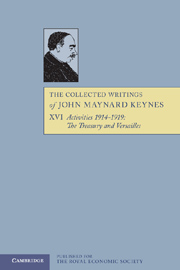4 - PREPARATORY WORK ON PEACE TERMS, 1916–1918
from Part II - The Problems of the Peace
Published online by Cambridge University Press: 05 November 2012
Summary
Keynes was drawn into the planning for the peace at what was still an early stage of the war when, at the request of the Board of Trade, he collaborated with Professor Sir W. J. Ashley in writing a ‘Memorandum on the Effect of an Indemnity’, dated 2 January 1916. In September 1918 he took part in a conference on the future development of the inter-allied economic organisation. From the time of the Armistice until the end of the year he was occupied with the Treasury's study of the whole question of reparations.
Ironically, the early document written with Ashley had an effect that could not have been to Keynes's liking. This, together with the Board of Trade memorandum on ‘Economic Considerations Affecting the Terms of Peace’ to which it was annexed, was produced for the use of the War Cabinet in November 1918, and the Hughes Committee, appointed to consider the feasibility of claiming an indemnity, had these two reports before them. When Lloyd George came to write The Truth About the Peace Treaties twenty years later, he attributed all schemes for extracting tribute from Germany over a long period of years to the inspiration of the Ashley–Keynes memorandum. Moreover, he wrote: ‘Mr Keynes is the sole patentee and promoter of that method of extraction.’
According to Lloyd George,
All the extravagant estimates formulated after the war as to Germany's capacity to pay were based on this plan …
- Type
- Chapter
- Information
- The Collected Writings of John Maynard Keynes , pp. 311 - 386Publisher: Royal Economic SocietyPrint publication year: 1978

